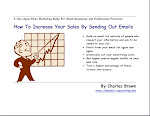If White Papers and Case Studies Were Siblings ...
Posted by Charles Brown at Wednesday, August 20, 2008If white papers and case studies were siblings, the white paper would be the older, serious-minded member of the family, while the case study would be the younger, creative one who tends to color outside of the lines.
And yet, I would argue they are both members of the same family and are essential tools in making a complex sale.
Imagine you are an executive with a company that needs to buy a software program to solve certain problems. Your job depends on your due diligence and your attention to detail. When you make your presentation to the board, you had better have all your facts together with every possible "i" dotted and "t" crossed.
But that said, buying decisions, even at that level, are based on emotions.
This is why companies that only produce white papers, or companies that produce dry "business school style" case studies are missing the point. Even high-level board members are people too with all the emotions of an individual consumer.
I am constantly urging my clients to include fiction-writing techniques like suspense, characters and plots into their case studies. The more your case study looks (and more importantly feels) like a feature article the better.
In fact if you want an example of what a really effective case study should look like, read the Wall Street Journal's middle column on its front page for a week. All of these middle column articles are features and many of them are case studies about companies that overcame - or are presently struggling with - serious challenges.
And they almost always include characters, suspense and plots.
Stories sell. But dry, emotionless case studies of the type many marketers learned in business school, are a kiss of death. The writers of such case studies might as well have just written another white paper. But then, the white paper format does a far better job of presenting purely factual information.
If you only want to appeal to the buyer's logical side, you are better off sticking with white papers.
So use the combined power of both "siblings" in your marketing. Let your white papers distill raw information, present the hard facts and persuade by logic and reasoning.
And let your wilder, creative case studies color outside the lines a little bit.
COPYRIGHT © 2008, Charles Brown
Add to Onlywire

Labels: case studies, white papers



Charles;
White papers are actually often very persuasive, not just fact based.
Take a look at this post:
http://www.writingwhitepapers.com/blog/2008/08/13/opinion-or-fact-whats-better/
Mike
Anonymous said...
8:45 AM
Mike,
That is a very good article. The meat is really in the exchange of comments that follows.
White papers can and should present opinions that are based on facts. The telling point in your article was that anyone can dig the internet for facts, but the real value of a white paper is the expert opinion as well.
In my past life as a lawyer, we used the word "argument" to say the same thing. This is argument in the classical form, which does not mean a heated exchange based on one's biases.
Lawyers build a persuasive argument based on the facts and the law. Step by step, a legal brief presents a position that is hoped to be compelling (one never knows what a judge and jury will do).
As I said in my article, white papers use facts to persuade by logic and reasoning.
But case studies are a good companion in that they present a microcosm of one customer's experience and persuades more on emotions than a case study does.
Therefore, both work very well together.
Thank you Michael, for the feedback.
Charles Brown said...
9:02 AM
Hi Charles,
Great post. I would also venture to say that the white paper as the older more serious sibling is often at home on a Friday or Saturday night and doesn't have as active a social life.
I agree with Mike that white papers can be persuasive but I find that, by definition, tend to be dry and incredibly detailed.
At Kadient we see into Sales organizations and find that our targets (VP of Sales, Director of Sales Enablement, VP of Marketing) would much rather read a case study that enables them to quickly put their finger on the pain points we solve, the process, and the benefits.
Heather
Director of Marketing
Kadient
www.kadient.com
Anonymous said...
10:06 AM